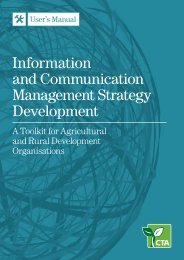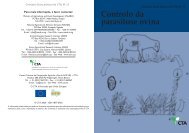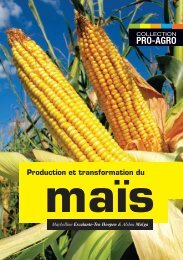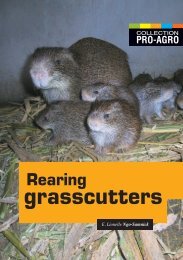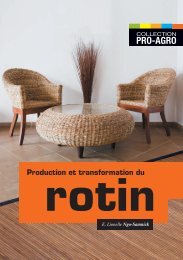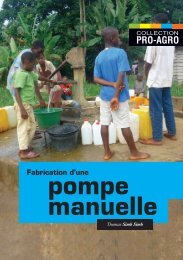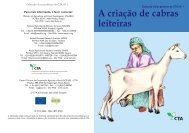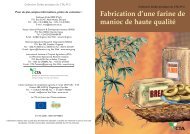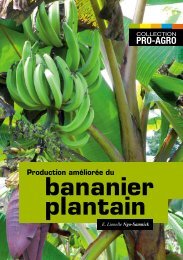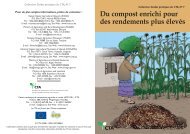PRO-AGRO production and processing Rattan - CTA Publishing
PRO-AGRO production and processing Rattan - CTA Publishing
PRO-AGRO production and processing Rattan - CTA Publishing
You also want an ePaper? Increase the reach of your titles
YUMPU automatically turns print PDFs into web optimized ePapers that Google loves.
<strong>Rattan</strong><br />
<strong>production</strong> <strong>and</strong> <strong>processing</strong><br />
E. Lionelle Ngo-Samnick<br />
COLLECTION<br />
<strong>PRO</strong>-<strong>AGRO</strong>
Contributors<br />
2<br />
TEXT<br />
E. Lionelle Ngo-Samnick<br />
REviEw<br />
Denis Mahonghol, Pascal Nondjock, Kokou E. Adabe,<br />
Yliane A. M. Yvanes-Giuliani <strong>and</strong> Rodger Obubo<br />
illusTRaTions<br />
Romarie Bougin, Béatriz Garcia, Eric Mengaptche <strong>and</strong><br />
Jin Ah Pok<br />
TRanslaTion<br />
David Dunn<br />
layouT<br />
Stéphanie Leroy<br />
The Pro-Agro Collection is a joint publication by Engineers Without Borders,<br />
Cameroon (ISF Cameroun) <strong>and</strong> The Technical Centre for Agricultural <strong>and</strong> Rural<br />
Co-operation (<strong>CTA</strong>).<br />
<strong>CTA</strong> – P.O. Box 380 – 6700 AJ Wageningen – The Netherl<strong>and</strong>s – www.cta.int<br />
ISF Cameroun – P.O. Box 7105 – Douala-Bassa – Cameroon –<br />
www.isf-cameroun.org<br />
© <strong>CTA</strong> <strong>and</strong> ISF 2012<br />
Cover: © Paul Maguire/123rf<br />
ISBN (<strong>CTA</strong>): 978-92-9081-499-3
Contents<br />
1<br />
2<br />
3<br />
4<br />
5<br />
6<br />
<strong>Rattan</strong> selection, <strong>production</strong> <strong>and</strong> management<br />
1.1 <strong>Rattan</strong> in mixed cropping ......................................................... 5<br />
1.2 <strong>Rattan</strong> as a single crop ............................................................... 6<br />
Sustainable harvesting of rattan<br />
2.1 Harvest period ...................................................................................... 10<br />
2.2 Harvesting procedure .................................................................. 10<br />
2.3 Post-harvest treatment ............................................................... 12<br />
<strong>Rattan</strong> <strong>processing</strong><br />
3.1 Traditional method ......................................................................... 13<br />
3.2 Modern method .................................................................................. 14<br />
<strong>Rattan</strong> transformation<br />
4.1 Equipment required ...................................................................... 17<br />
4.2 Transformation process ............................................................. 18<br />
<strong>Rattan</strong> commercialization<br />
5.1 Commercialization of raw rattan ...................................... 21<br />
5.2 Commercialization of transformed rattan ................ 22<br />
Additional information<br />
6.1 Selected references .......................................................................... 24<br />
6.2 Useful contacts ................................................................................... 25
4<br />
General<br />
information<br />
<strong>Rattan</strong> is a vine-like, thorny palm that can climb trees by using a form of<br />
flagellum at the end of its leaves called a cirrus (short, curved thorns).<br />
Despite some common characteristics, there is a great degree of<br />
variety in terms of form <strong>and</strong> growth, resulting in roughly 600 different<br />
species of rattan. Although the majority of species currently identified<br />
are of Asian origin, 20 of them are endemic in Africa. The diameter of<br />
the stems varies between 3 mm to more than 20 cm, <strong>and</strong> the length<br />
ranges from a few metres to more than 200 m.<br />
In general, rattan can be divided into two main groups, based on how<br />
it is used <strong>and</strong> the diameter of the cane: large diameter rattan such as<br />
Laccosperma secundiflorum, <strong>and</strong> small diameter species, also known<br />
as lianas, such as Eremospatha macrocarpa. <strong>Rattan</strong> can be grown<br />
<strong>and</strong> harvested in a sustainable manner due to its rapid growth <strong>and</strong> its<br />
ability to adapt to a very wide variety of ecological conditions. In addition,<br />
its use in furniture <strong>production</strong> provides an alternative to timber<br />
logging <strong>and</strong> thereby contributes to the protection of forest resources.
1<br />
RAttAN SELEctiON,<br />
<strong>PRO</strong>DuctiON AND MANAGEMENt<br />
<strong>Rattan</strong>s are grown almost exclusively in the wild. Today, they are<br />
threatened with overexploitation as a result of poor management practices.<br />
It is therefore important to promote cultivation. To achieve this, it is necessary<br />
to find l<strong>and</strong> that possesses similar characteristics to those of tropical<br />
<strong>and</strong> swamp forests. Although rattan germinates best in partial shade, it<br />
grows most favourably in sunlight after transplanting.<br />
<strong>Rattan</strong> can be cultivated in mixed cropping with other plants, or sown on<br />
l<strong>and</strong> recently cleared by fire.<br />
1.1 <strong>Rattan</strong> in mixed cropping<br />
Two to three months before the cropping season:<br />
• Weed the l<strong>and</strong> <strong>and</strong> cut down certain trees;<br />
• Immediately after that, sow with mature rattan seed, or plant seedlings<br />
or plantlets. A planting density of 50 to 170 plants per hectare is recommended.<br />
Seeds should be planted before burning the l<strong>and</strong> as the heat can<br />
aid germination;<br />
• After one to two months, burn the field;<br />
• After that, plant food crops such as rice, maize, cassava, etc. In the first<br />
year, the young plants in the rattan crop require little maintenance;<br />
• One or two years later, leave the cultivated l<strong>and</strong> for a new plot. In the<br />
meantime, the rattan will continue to grow amid this secondary forest<br />
growth. In this way, the rattan crop is incorporated into the cycles of shifting<br />
cultivation.<br />
5
1.5 to<br />
2 metres<br />
6<br />
Once growth is established, the rattans can remain in the fields for long<br />
periods. Cane harvesting can begin eight years after planting <strong>and</strong> may be<br />
extended over several years. Peak harvesting occurs between 24 <strong>and</strong> 36<br />
years after planting, <strong>and</strong> declines as of 37 to 43 years.<br />
1.2 <strong>Rattan</strong> as a single crop<br />
<strong>Rattan</strong> can be easily cultivated from seed by using the following steps:<br />
>>> Making a nursery<br />
The nursery can be built from local materials such as bamboo, palm leaves,<br />
etc. It is best to use humus-rich soil (a mix of black earth <strong>and</strong> s<strong>and</strong> or<br />
sawdust) when preparing the seedbeds. Adding s<strong>and</strong> or sawdust improves<br />
drainage <strong>and</strong> prevents the roots of the seedlings being damaged during<br />
transplanting.<br />
Palm leaves<br />
Nursery<br />
Bamboo<br />
>>> seed collection, preparation, storing <strong>and</strong> sowing<br />
Collect ripe fruit that has recently fallen, with a bright red or orange colour<br />
because this means the seeds are mature <strong>and</strong> ready to germinate.<br />
In order to speed up the germination process, first remove the seeds<br />
from the skin <strong>and</strong> pulp of the fruit by crushing it with your h<strong>and</strong> or foot. To<br />
remove the pulp, soak the seeds in water for two days <strong>and</strong> then rub them<br />
between your h<strong>and</strong>s. After washing, sow them as soon as possible.
<strong>Rattan</strong> seeds can be stored in a damp condition for several weeks by wrapping<br />
them first in paper (toilet paper is recommended), then in a plastic bag.<br />
However, the seeds will gradually lose their germination potential. To store<br />
them for long periods, wash the seeds every three to four days <strong>and</strong> change<br />
the wrapping paper.<br />
Large diameter seeds can be sowed 5 cm apart; small diameter seeds<br />
2.5 cm apart.<br />
Sow the seeds in the seedbed following the recommended spacing, <strong>and</strong> then<br />
push them 10 cm into the ground, cover with soil <strong>and</strong> water lightly.<br />
<strong>Rattan</strong> seeds<br />
After sowing, weed <strong>and</strong> water the seedbeds regularly, <strong>and</strong> make sure that<br />
the seeds remain covered with soil at all times. Germination occurs mostly<br />
two to three months after sowing. When they first appear, the leaves look<br />
like needles.<br />
Besides using seeds, rattan can also be cultivated by vegetative propagation,<br />
using suckers or rhizomes. However, it can be problematic to collect enough<br />
suckers or rhizomes for large-scale cultivation because they are larger <strong>and</strong><br />
more time-consuming than seeds.<br />
7
8<br />
>>> Transplanting seedlings in polythene bags<br />
After two months, several leaves will already be open, <strong>and</strong> the young plant<br />
can be transplanted. This is done with polythene bags 12.5 cm wide <strong>and</strong><br />
20 cm deep, two thirds full with the same soil mix as in the seedbeds. In<br />
order to avoid damaging the roots, a mix of s<strong>and</strong> or sawdust can be added<br />
to the soil mix.<br />
Before beginning, water the seedbed abundantly, remove the plant carefully<br />
<strong>and</strong> place it in the bag. Then fill the bag with soil, press down gently to<br />
steady the plant in the pot, <strong>and</strong> water lightly.<br />
Place the pots with transplanted seedlings in the nursery, in blocks of four<br />
pots with walkways between the blocks. This will allow easy access to each<br />
seedling when weeding <strong>and</strong> watering.<br />
The seedlings need regular weeding <strong>and</strong> watering. Keep the nursery clean<br />
<strong>and</strong> ordered at all times, <strong>and</strong> make sure the seedlings are in the shade.<br />
Remove sick or infested pants. After five to six months, the seedlings can<br />
be replanted.<br />
>>> Replanting in the field<br />
In order to grow well, rattan requires sunlight <strong>and</strong> a climbing support. It is<br />
therefore a good idea to replant on uncultivated l<strong>and</strong>. Planting should take<br />
place during the rainy season.<br />
3 m<br />
7 m<br />
Cropping pattern
Do not damage<br />
the young<br />
plants during<br />
transportation<br />
Fruit Seed<br />
Avoid damaging the young plants while transporting them to the field. For<br />
example, do not cut their leaves or roots; otherwise they could dry out. The<br />
cropping pattern is 7 m x 3 m, or 476 plants per hectare.<br />
The planting holes should be 20 cm wide <strong>and</strong> 30 cm deep. Fill one third<br />
with humus-rich soil or compost, then remove the plant from the bag <strong>and</strong><br />
place it, together with the soil clod, in the hole <strong>and</strong> fill with earth.<br />
Month 3<br />
Seed germination<br />
Growing rattan<br />
Development of rattan<br />
Year 5<br />
<strong>Rattan</strong> harvesting<br />
In the first three years, water during the dry season <strong>and</strong> weed the plots<br />
regularly. As of the fourth year, guide the stems towards the support<br />
trees.<br />
If conditions are good, rattan can reach maturity within five years.<br />
9
10<br />
2<br />
SuStAiNABLE<br />
hARvEStiNG Of RAttAN<br />
Harvesting rattan requires strength, intelligence, courage <strong>and</strong> endurance,<br />
to avoid both the thorns <strong>and</strong> hooks of the climbing stems as well<br />
as insect stings.<br />
Harvesting equipment: machete, gloves <strong>and</strong> a file. Wear long trousers, a<br />
long-sleeved shirt <strong>and</strong> boots.<br />
2.1 Harvest period<br />
adult canes can be identified by a lack of leaves at their base. A rattan<br />
stem should be harvested when it meets the majority of the following<br />
criteria:<br />
• The skin colour has turned brown;<br />
• The thorns on the stem <strong>and</strong> the leaves are drying out<br />
<strong>and</strong> beginning to fall;<br />
• Flowers or fruits have already appeared;<br />
• The stem is more than 20-25 cm long.<br />
2.2 Harvesting procedure<br />
• Determine beforeh<strong>and</strong> the species of rattan desired, according to its<br />
subsequent use. In this way, one can avoid pointless cutting of inappropriate<br />
species. Identify the mature stems of the desired species.
Identifying mature<br />
rattan stems<br />
• Cut the mature stems 10 cm above the ground, taking care to avoid<br />
young shoots. Throughout the operation, avoid damaging surrounding trees<br />
<strong>and</strong> bushes.<br />
• Detach the cut stem from the crown of the bush by pulling it downwards,<br />
preferably with the help of one or two other people, <strong>and</strong> if necessary, climb<br />
into the trees in order to untangle the parts of the stem that are wrapped<br />
around branches.<br />
• After having detached the main part of the stem, cut it into canes of various<br />
lengths, depending on the species, the size of the rattan, its intended<br />
use or the specifications of the buyer. In cases where the whole length of<br />
the stem is detached, cut off the last three metres, as they are unfit for<br />
<strong>processing</strong>, but may be useful for tying the rattan bundles.<br />
• Stems are typically cut into lengths of 4 m for large diameter rattan, <strong>and</strong><br />
10 m for small diameter rattan.<br />
• Sort through the canes in order to reject subst<strong>and</strong>ard quality canes.<br />
• After harvesting, the rattan should be tied in bundles <strong>and</strong> transported for<br />
local use or to transformation centres.<br />
Always cut the mature stems 10 cm above the ground, avoiding<br />
young shoots<br />
11
12<br />
<strong>Rattan</strong> bundles<br />
If any fruit is present, collect it for possible future cultivation.<br />
2.3 Post-harvest treatment<br />
The leaf sheaths adhering to the cane <strong>and</strong> the hard, shiny silicified<br />
epidermis should ideally be removed within 24 hours of harvesting. This<br />
can be carried out by twisting the cane by h<strong>and</strong> <strong>and</strong> rubbing it with fine s<strong>and</strong>,<br />
steel wool, coconut or sack cloth. Smooth over the bumps made from the<br />
sprouting points by burning the canes, which will close any cuts <strong>and</strong> prevent<br />
any sap still in the stem from forming drops on the surface. The canes have a<br />
dull colour in their natural condition, but a sulphur treatment will remove any<br />
remaining roughness <strong>and</strong> give the canes a smooth, shiny appearance.<br />
After this, the canes are dried for about one week to prevent any deterioration.
3<br />
RAttAN<br />
<strong>PRO</strong>cESSiNG<br />
ideally, rattan should be processed as soon as it has been harvested.<br />
Processing comprises a number of treatments applied to raw rattan in<br />
preparation for its subsequent transformation into finished products. Processing<br />
improves the quality of the finished product <strong>and</strong> the preservation of<br />
the raw rattan, <strong>and</strong> its by-products, by reducing post-harvest losses. There<br />
are two methods of <strong>processing</strong>: the traditional <strong>and</strong> the modern.<br />
3.1 Traditional method<br />
This is a low-cost solution; the only tools required being a tape measure,<br />
some brushes, a knife <strong>and</strong> a file. It is a good idea to wear long trousers, a<br />
long-sleeved shirt <strong>and</strong> plastic s<strong>and</strong>als or boots.<br />
The three steps of the traditional method<br />
• Scrape the skin of the rattan as soon as it arrives at the transformation<br />
workshop;<br />
• Leave to dry for three to seven days in order to reduce the water content;<br />
as a result, the rattan can be preserved for up to a month <strong>and</strong> a half. Large<br />
diameter rattan can then already be used to make frames for furniture;<br />
• Small diameter rattans are bent <strong>and</strong> split in order to produce strips that<br />
can later be used as bindings or in weaving.<br />
13
14<br />
3.2 Modern method<br />
although more expensive, this method produces higher quality products.<br />
In addition to the tools required in the traditional method, it is<br />
also necessary to have two chains, a curing tank, face masks <strong>and</strong> a pair<br />
of gloves..<br />
The five steps of the modern method<br />
1 sort the rattan canes. This is often done during harvesting, but it is<br />
useful to check that it has been done correctly. After the initial selection,<br />
the artisan should sort the canes according to their diameter, an important<br />
job before the next step.<br />
2 Cure the canes in boiling diesel oil in order to rid them of insects <strong>and</strong><br />
larvae, reduce fungal disease <strong>and</strong> increase durability from 1.5 months<br />
to at least six months. In addition, curing gives a better colour to large<br />
rattans, reveals internal flaws in the canes <strong>and</strong> eliminates the need to<br />
scrape the rattan before it can be used.<br />
Curing tank
The curing process<br />
• Light a fire beneath the curing tank filled with diesel oil <strong>and</strong> wait until it<br />
comes to the boil. Wrap a chain around the rattan bundle. Put on a face<br />
mask <strong>and</strong> gloves before placing the rattan in the diesel oil. The duration<br />
of the curing process depends on the species, the diameter <strong>and</strong> the<br />
water content of the canes. Freshly harvested rattan will take 15 to 30<br />
minutes; rattan harvested more than three days previously will take only<br />
12 to 20 minutes. Likewise, freshly cut lianas will take 8 to 10 minutes<br />
of boiling, <strong>and</strong> only 6 to 8 minutes if they were cut more than three days<br />
previously.<br />
• Lift the rattan out <strong>and</strong> hold it on the edge of the tank for 30 seconds<br />
in order to remove excess oil. During this procedure, it is extremely<br />
important to avoid spilling diesel oil on the ground. It is therefore recommended<br />
to install the curing tank on a concrete surface. Large diameter<br />
rattan will have a golden colour <strong>and</strong> a varnished appearance. After<br />
removal from the curing tank, clean the canes with a cloth <strong>and</strong> sawdust<br />
to remove excess oil.<br />
safety precautions during the curing process<br />
• Use superior quality equipment in order to avoid oil leaks, burns <strong>and</strong><br />
poisoning.<br />
• Have a fire extinguisher ready at all times.<br />
• Ventilate the treatment workshop <strong>and</strong> make sure the interior <strong>and</strong> surrounding<br />
area are clean <strong>and</strong> tidy.<br />
• Follow the steps of the process carefully in order to avoid confusion or<br />
panicky movements.<br />
• Make sure the oil never comes into contact with the fire.<br />
• Do not heat the oil above 100°C.<br />
alternative process<br />
The canes can be steeped in a mixture of diesel oil <strong>and</strong> coconut or<br />
palm oil in order to rid them of unwanted gums <strong>and</strong> resins as well<br />
as moisture.<br />
There is great diversity in this treatment with mixtures varying in<br />
concentration from 50:50 to 90:10 diesel to other oil, temperatures<br />
from lukewarm to 100°C, <strong>and</strong> periods of immersion from 10<br />
to 40 minutes. The rattan is then sundried for 7-12 days.<br />
15
16<br />
3 The canes are placed upright <strong>and</strong> dried for 10-14 days.<br />
4 once the rattan is dried, any canes showing defects are rejected,<br />
while the remainder are sorted according to the presence or absence<br />
of marks on the skin. Large diameter rattan can already be used in the<br />
transformation process.<br />
5 small rattans are scrubbed then bent <strong>and</strong> split in order to produce<br />
strips that can be used for binding or weaving. Large immature rattans<br />
bend during drying <strong>and</strong> can be prepared for use as chair seats or mats.<br />
Processed rattan can be preserved for several months in a warm <strong>and</strong><br />
dry environment.<br />
Other chemical treatments can be applied to rattan during the transformation<br />
process.<br />
Reject any canes with defects <strong>and</strong> sort the good canes into categories.
4<br />
RAttAN<br />
tRANSfORMAtiON<br />
<strong>Rattan</strong> has a great variety of uses: house construction, wickerwork,<br />
furniture, fishing nets, etc. The transformation process includes all the<br />
techniques applied to the raw rattan, treated or partially treated, as part of<br />
its transformation into a finished product (furniture, baskets, etc.).<br />
4.1 Required equipment<br />
The first step is to get training <strong>and</strong> the capital necessary to set up a<br />
transformation activity. Training in wickerwork can be done by working as<br />
an apprentice for six months to a year.<br />
Some work tools<br />
17
18<br />
Traditionally, wickerwork requires the following tools: knife, pencil, set<br />
square, tape measure, hacksaw, hammer, pliers, a welding torch <strong>and</strong><br />
brushes. Additional tools can facilitate work <strong>and</strong> produce higher quality<br />
products, for example, a stapler, hole punch, electric saw, steam box,<br />
compressed air spray <strong>and</strong> a clamp. Finally, the artisan should also have a<br />
stock of nails, screws, glue, varnish, gas, Xylamon <strong>and</strong> stainer.<br />
It is possible to set up a traditional workshop for less than 75 euros for<br />
the basic equipment.<br />
4.2 Transformation process<br />
note the following steps:<br />
• First decide on the model to make, then choose the appropriate canes;<br />
• Scrape the small cane using a kitchen knife in order to remove the<br />
epidermis <strong>and</strong> split the cane into strips; scrape the large rattan too, if<br />
necessary;<br />
Scraping the cane
• Pull the large diameter rattan until they are straight, then using a pencil,<br />
mark the bending or cutting points. The canes will be steamed before<br />
being twisted <strong>and</strong> bent or else used to form the skeleton structure of<br />
furniture products;<br />
• Cut the canes to the required dimensions;<br />
Transformation process<br />
• Heat the canes in a steam box, <strong>and</strong> then bend them on a work bench<br />
using templates. Failing this, use a blowtorch to facilitate bending;<br />
• Construct the desired product using nails, screws <strong>and</strong> staples;<br />
• Soak the strips of small diameter rattan in water for two to five minutes,<br />
<strong>and</strong> then use them to bind the joints. Make sure the binding looks attractive,<br />
<strong>and</strong> hides as many of the nails as possible;<br />
• Use weaving <strong>and</strong> decorative techniques to finish the product. Furniture<br />
products should be treated with Xylamon in order to protect them from insects<br />
<strong>and</strong> larvae. Other chemical treatments, including staining, varnishing<br />
or painting with oil, can also protect products from fungal attack;<br />
19
20<br />
Some weaving techniques<br />
• Burn off any fibres <strong>and</strong> apply an initial coat of varnish. Leave to dry in the<br />
air or in the sun for 4 to 24 hours, <strong>and</strong> then apply a second coat of varnish;<br />
• Alternatively, after making the basic skeleton structure, the furniture product<br />
can be s<strong>and</strong>ed down <strong>and</strong> stained, using an electrostatic spray gun to<br />
apply polyurethane lacquer. This will protect the furniture from the effects<br />
of the sun, which is particularly useful for outdoor furniture that will have<br />
significant exposure to sunlight. After this, the hard surface is once again<br />
s<strong>and</strong>ed down to remove any remaining roughness. To finish off, apply a<br />
matt or gloss polyurethane varnish;<br />
• Inspect the finished furniture <strong>and</strong> carry out a quality control check. If the<br />
products meet the desired st<strong>and</strong>ards, then they are ready to be sold.<br />
Finished rattan products
5<br />
RAttAN<br />
cOMMERciALizAtiON<br />
More than 700 million people around the world trade or use rattan for<br />
multiple purposes. Using modern <strong>processing</strong> <strong>and</strong> transformation techniques<br />
can generate considerable revenue <strong>and</strong> can improve livelihoods<br />
both in rural <strong>and</strong> urban areas. <strong>Rattan</strong> is currently commercialized in two<br />
ways: as raw material <strong>and</strong> as finished products.<br />
5.1 Commercialization of raw rattan<br />
The most commonly traded rattans in africa are the large diameter<br />
Laccosperma secundiflorum <strong>and</strong> the small diameter Eremospatha hookeri<br />
(E. macrocarpa) because they both possess excellent characteristics in<br />
terms of pliability (flexible <strong>and</strong> strong canes) <strong>and</strong> aesthetic value (evenly<br />
shaped canes that are easy to polish).<br />
Raw rattans<br />
21
22<br />
In Africa, the unit of sale is a bundle or a bale. The harvester is usually<br />
paid per number of canes, each with a value of 100 to 200 F CFA (0.15<br />
to 0.31 euros) for both species, depending on the quality. The unit price<br />
for large diameter canes can sometimes reach 300 F CFA (0.46 euros).<br />
A skilled harvester can cut around 140 canes per day, which results in a<br />
guaranteed daily income of 14 000 F CFA (21.30 euros).<br />
It is also possible to work as a wholesaler for raw rattan in large urban<br />
areas. Quality control is especially important in this scenario: make sure<br />
there is no unwanted gum or resin, or any trace of mould. A regular client<br />
base depends on providing high quality rattan that is pliable, supple, strong<br />
<strong>and</strong> evenly shaped. The canes should be able to bend without splitting.<br />
<strong>Rattan</strong> canes can be sold all year round, providing a stable <strong>and</strong> regular<br />
supplementary income.<br />
There is also potential income generation in transforming rattan cane into<br />
furniture.<br />
5.2 Commercialization of transformed rattan<br />
<strong>Rattan</strong> products include kitchen utensils (trays, baskets, etc.), furniture<br />
(cupboards, chairs, beds, etc.), decorative objects (flower pots, statues,<br />
etc.) <strong>and</strong> models for hairdressing <strong>and</strong> tailoring (mannequins, etc.).<br />
The quality of the products depends on the creativity <strong>and</strong> originality of the<br />
design, consistency in <strong>production</strong>, sturdiness, traces or absence of burn<br />
marks, careful use of nails <strong>and</strong> their appearance, <strong>and</strong> the style <strong>and</strong> quality<br />
of weaving.
Item<br />
Purchase of<br />
canes (250)<br />
Shop rental<br />
Casual<br />
labour<br />
Equipment<br />
Local<br />
taxes<br />
tOtAL<br />
Sale of furniture <strong>and</strong> decorative<br />
objects made from rattan<br />
Simple furniture is the most commonly found product in artisans’ displays,<br />
<strong>and</strong> provide a minimum monthly profit of 150 euros. The quantity of cane<br />
used can vary from one product to the next.<br />
EXPEnsEs<br />
Unit<br />
Bale<br />
of canes<br />
-<br />
-<br />
-<br />
Annual<br />
Unit cost<br />
(US$)<br />
8<br />
fixes rate<br />
fixes rate<br />
fixes rate<br />
fixes rate<br />
Total price<br />
(US$)<br />
2000<br />
322<br />
382<br />
783<br />
210<br />
3 697<br />
Item<br />
Sale of<br />
pieces of<br />
furniture<br />
income<br />
an artisan’s trading account for 250 rattan canes<br />
Unit<br />
Piece<br />
of<br />
furniture<br />
RECEiPTs<br />
Unit cost<br />
(US$)<br />
85<br />
Total price<br />
(US$)<br />
5 270<br />
1 573<br />
23<br />
Source: Zoro Bi <strong>and</strong> Kouakou, 2004
24<br />
6<br />
ADDitiONAL<br />
iNfORMAtiON<br />
6.1 Selected references<br />
asaha, s. 2003. A socio-economic survey <strong>and</strong> monitoring of the rural,<br />
peri-urban <strong>and</strong> urban rattan markets of Cameroon. Technical note No. 17.<br />
36pp. African <strong>Rattan</strong> Research Programme <strong>and</strong> University College, London.<br />
Limbe, Cameroon <strong>and</strong> London.<br />
Fao. 1999. Recent research into African rattans (Palmae): A valuable<br />
non-wood forest product from the forests of Central Africa, by T.C.H.<br />
Sunderl<strong>and</strong>. Current Research Issues <strong>and</strong> Prospects for Conservation <strong>and</strong><br />
Development. FAO Forestry Department. Rome.<br />
Kwaku, M. 2006. Present Status of Research <strong>and</strong> Development on<br />
Bamboo <strong>and</strong> <strong>Rattan</strong> in Africa <strong>and</strong> Prospects for Future Co-operation with<br />
China. Report from West Africa to INBAR (International Center for Bamboo<br />
<strong>and</strong> <strong>Rattan</strong> Open Fund Research Programme).<br />
sunderl<strong>and</strong>, T.C.H. 2003. Two new species of rattan (Palmae: Calamoideae)<br />
from the forests of West <strong>and</strong> Central Africa. Kew Bull., 58: 987-<br />
990.<br />
sunderl<strong>and</strong>, T.C.H. 2004. <strong>Rattan</strong> resources <strong>and</strong> use in West <strong>and</strong> Central<br />
Africa. Publication of the African <strong>Rattan</strong> Research Programme of the Limbe<br />
Botanic Garden, Limbe, Cameroon.<br />
Zoro B, i.a. <strong>and</strong> Kouakou, l. 2004. Étude de la filière rotin dans le district<br />
d’Abidjan (Sud Côte d’Ivoire). Biotechnol. Agron. Soc. Environ., 8(3):<br />
199-209.
6.2 Useful contacts<br />
n international network for Bamboo <strong>and</strong> <strong>Rattan</strong> (inBaR)<br />
P.O. Box 100102-86<br />
Beijing 100102,<br />
P. R. China<br />
Tel: +86-10-6470 6161, +86-10-8471 3337, +86-10-6471 7108<br />
Fax: +86-10-6470 2166<br />
Email: info@inbar.int<br />
Website: www.inbar.int<br />
n african <strong>Rattan</strong> Research Programme<br />
Limbe Botanic Garden<br />
BP 437 Limbe, Cameroon<br />
Tel: +237-3333 2620<br />
Email: afrirattan@aol.com<br />
25
in the same collection:<br />
Rearing<br />
grasscutters<br />
E. Lionelle Ngo-Samnick<br />
COLLECTION<br />
<strong>PRO</strong>-<strong>AGRO</strong><br />
Rearing grasscutters<br />
E. Lionelle Ngo-Samnick<br />
How to make a h<strong>and</strong>pump<br />
Thomas Simb Simb<br />
Improved plantain <strong>production</strong><br />
E. Lionelle Ngo-Samnick<br />
Maize <strong>production</strong> <strong>and</strong> <strong>processing</strong><br />
Maybelline Escalante-Ten Hoopen <strong>and</strong> Abdou Maïga
<strong>Rattan</strong><br />
<strong>production</strong> <strong>and</strong> <strong>processing</strong><br />
Pro-Agro is a collection of practical, illustrated guides that are jointly published by<br />
<strong>CTA</strong> <strong>and</strong> ISF Cameroun. They are an ideal source of information for farmers, rural<br />
communities <strong>and</strong> extension workers in tropical <strong>and</strong> subtropical regions.<br />
This technical guide gives a general overview of the cultivation, harvesting, treatments,<br />
transformation <strong>and</strong> commercialization of rattan. It aims to promote sustainable <strong>and</strong><br />
effective rattan cultivation as a reliable alternative to timber exploitation.<br />
• The Technical Centre for Agricultural <strong>and</strong> Rural Cooperation (<strong>CTA</strong>) is a joint<br />
international institution of the African, Caribbean <strong>and</strong> Pacific (ACP) Group of States<br />
<strong>and</strong> the European Union (EU). Its mission is to advance food <strong>and</strong> nutritional security,<br />
increase prosperity <strong>and</strong> encourage sound natural resource management in ACP<br />
countries. It provides access to information <strong>and</strong> knowledge, facilitates policy dialogue<br />
<strong>and</strong> strengthens the capacity of agricultural <strong>and</strong> rural development institutions <strong>and</strong><br />
communities. <strong>CTA</strong> operates under the framework of the Cotonou Agreement <strong>and</strong> is<br />
funded by the EU.<br />
• Engineers without Borders (EWB) is a network of professionals in more than 52<br />
countries to promote human development through improved access to scientific <strong>and</strong><br />
technical knowledge. In Cameroon, EWB works together with local people to improve<br />
their livelihoods <strong>and</strong> strengthen their technical capacity by sharing <strong>and</strong> diffusing information<br />
adapted to their needs.




